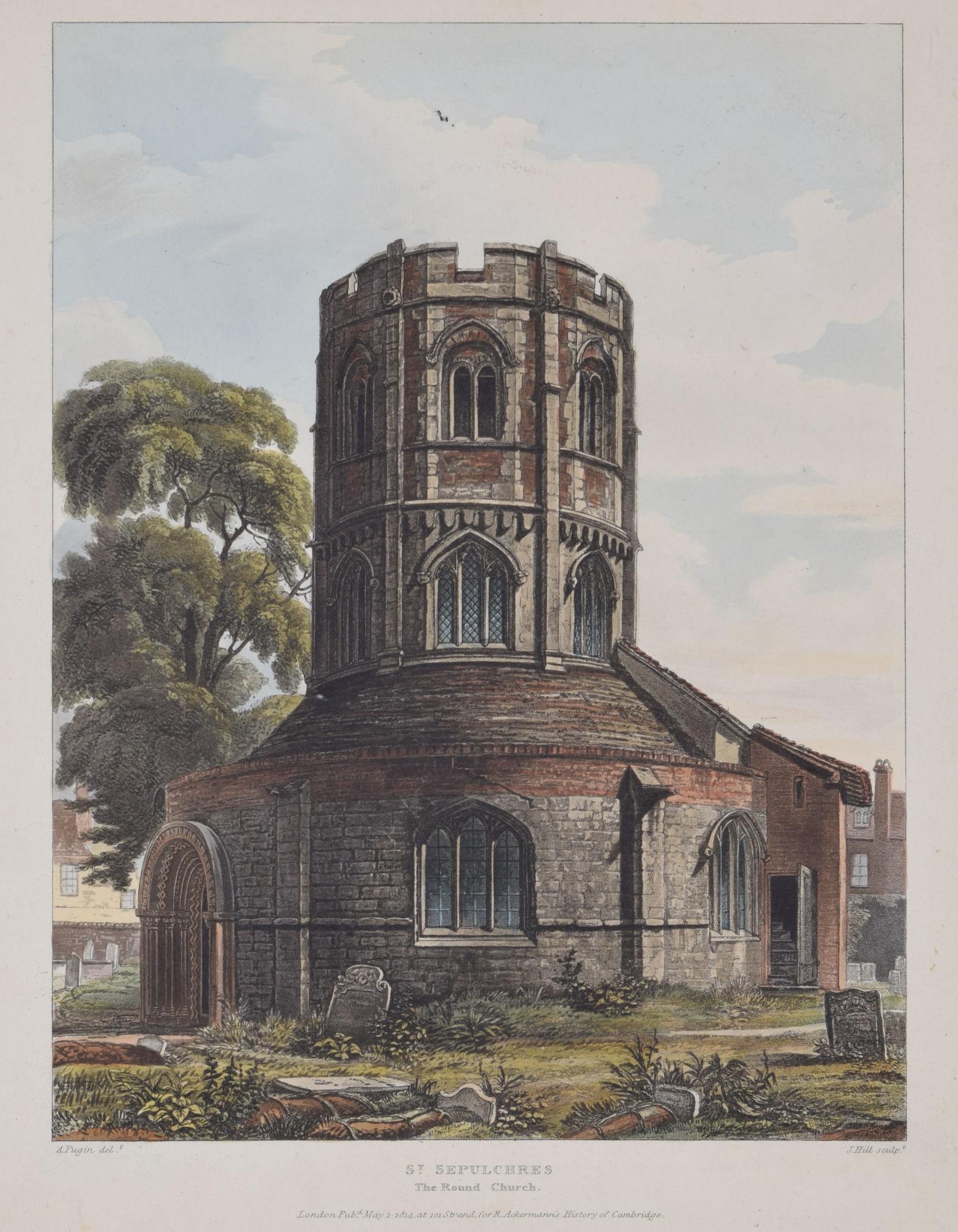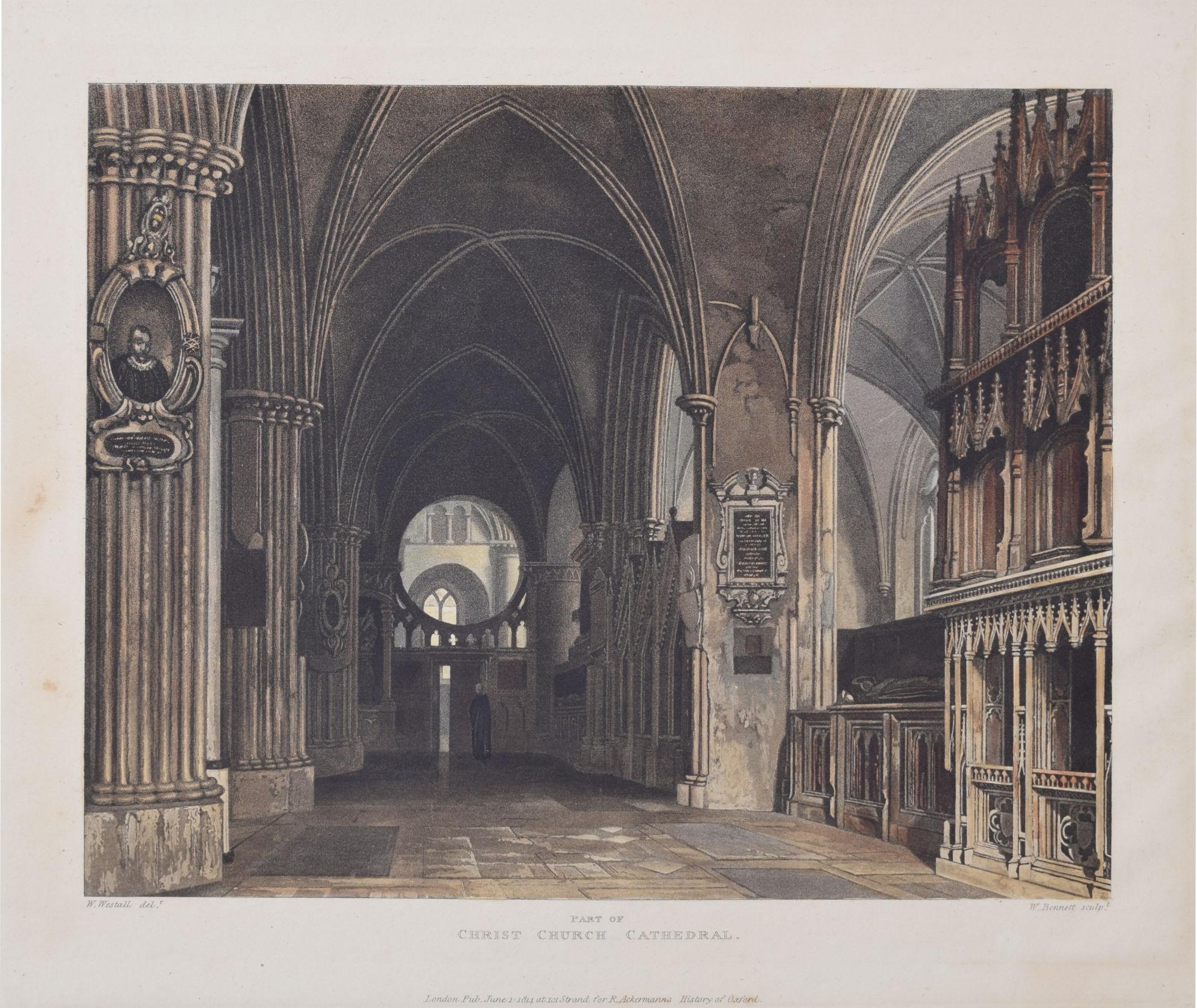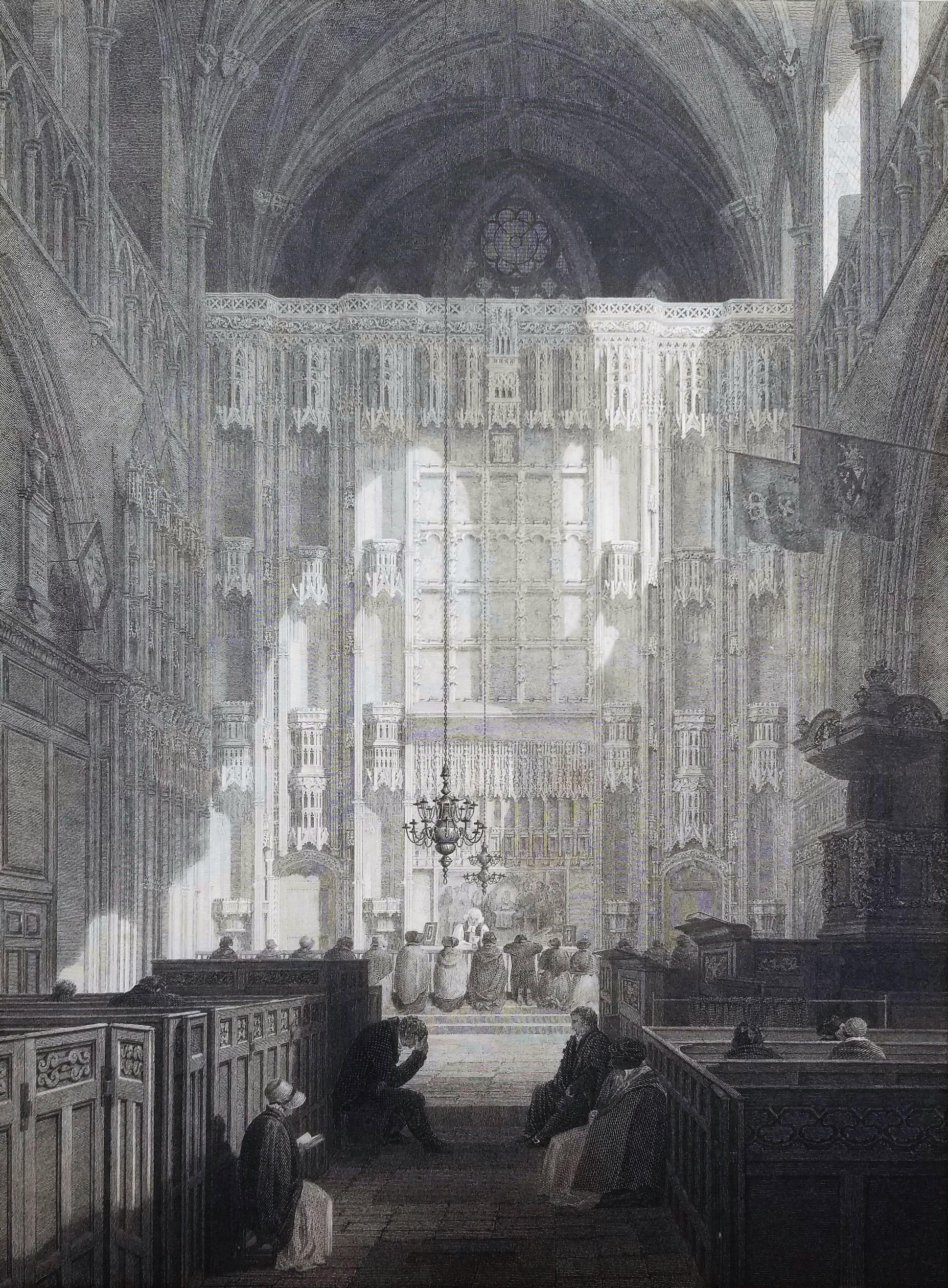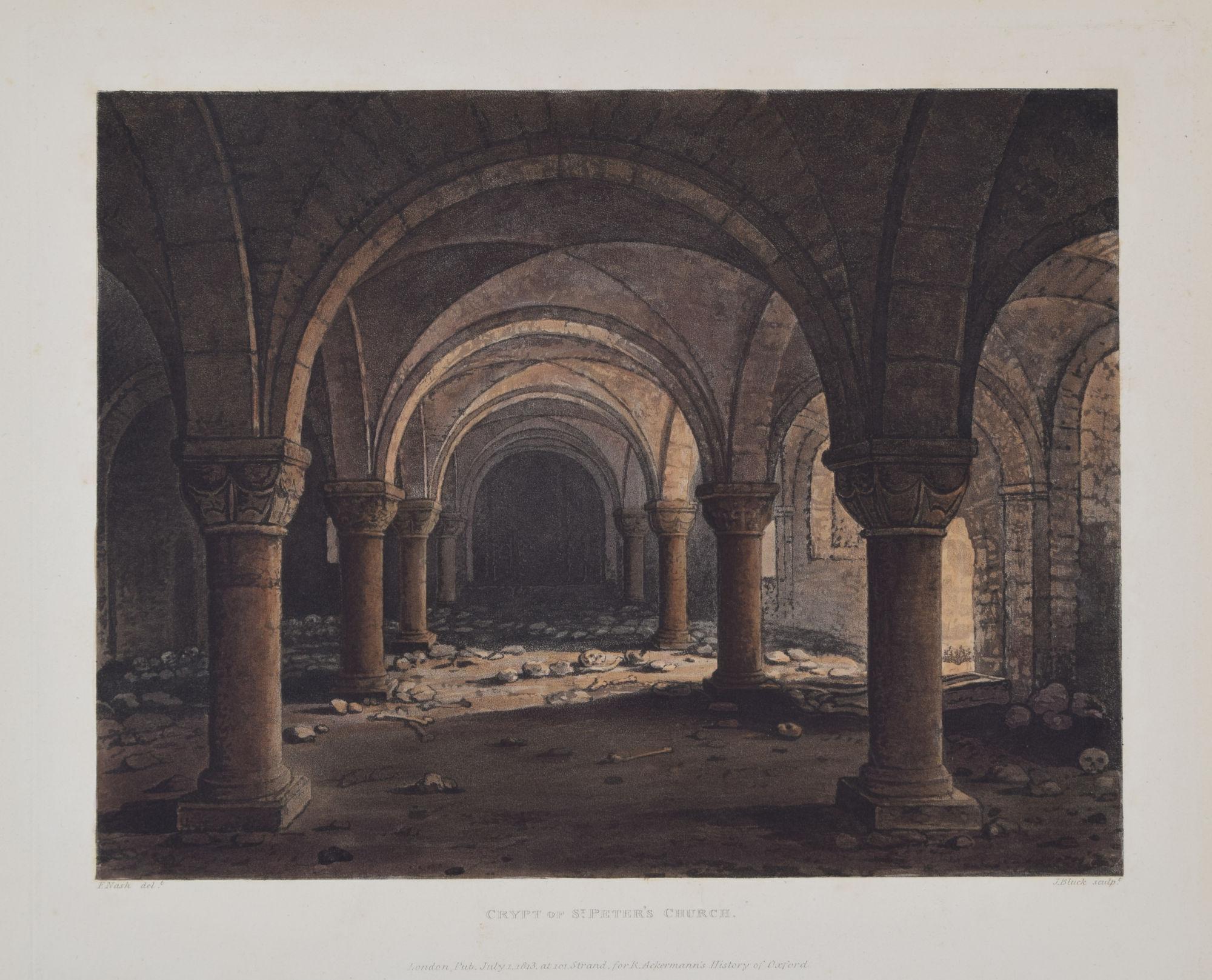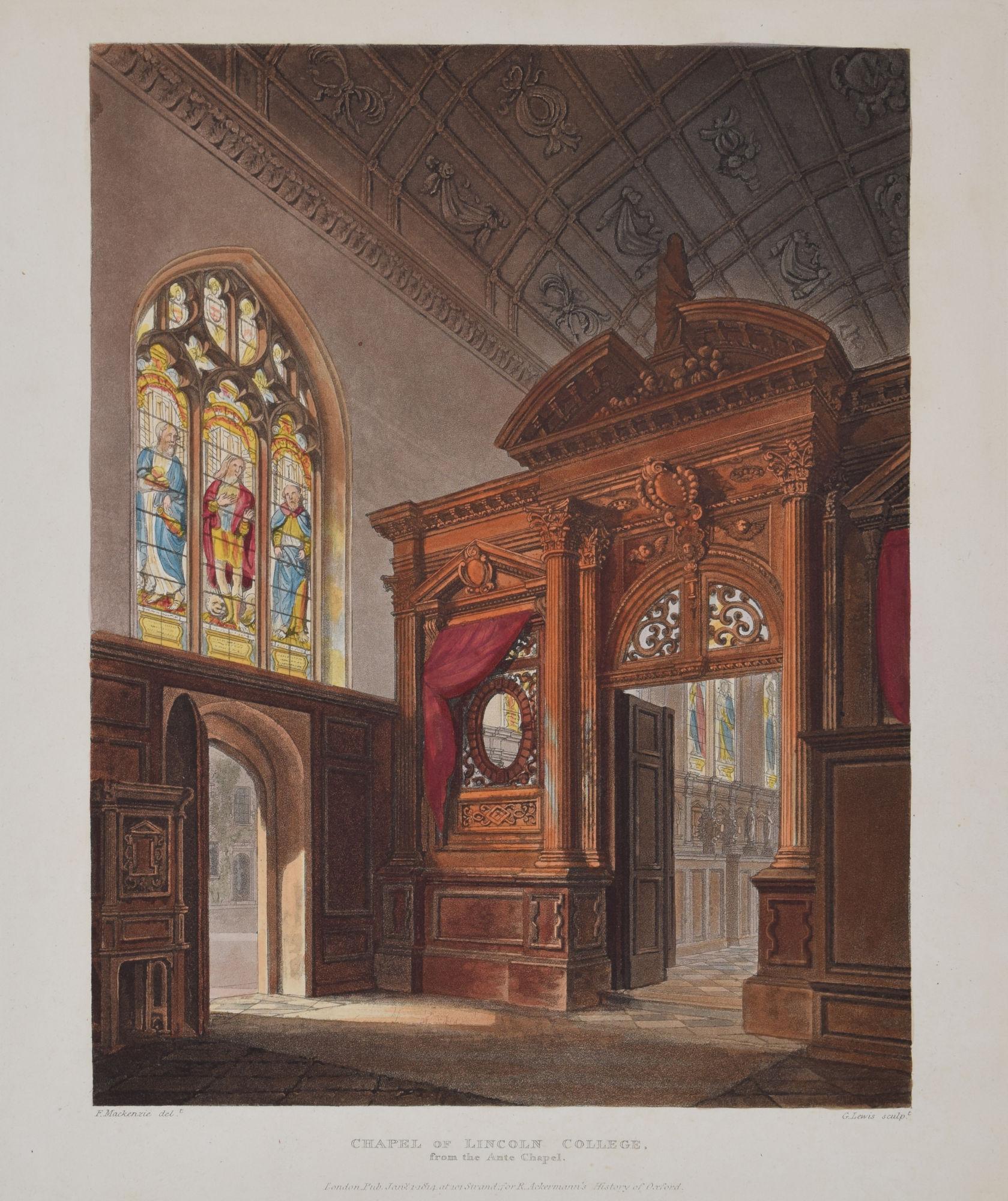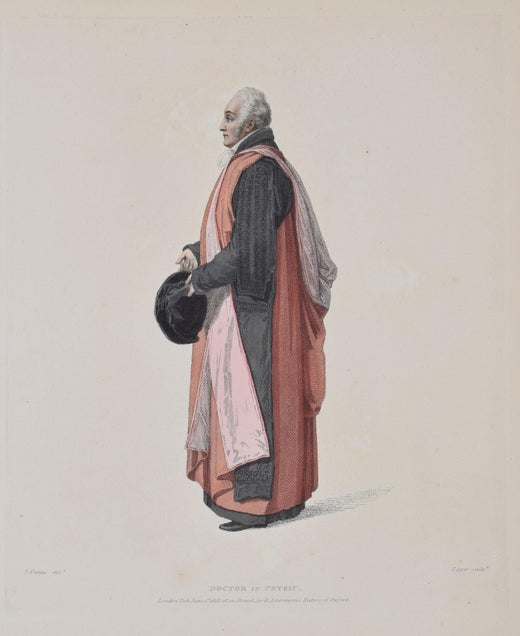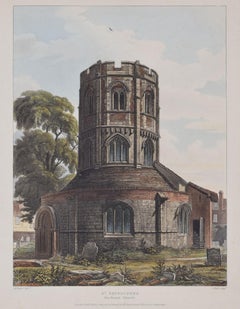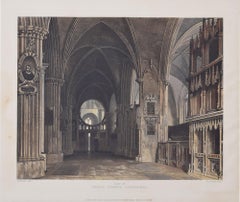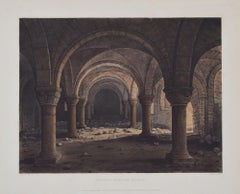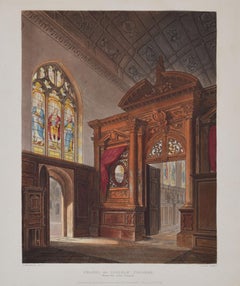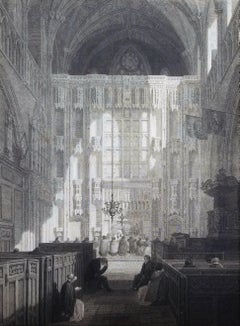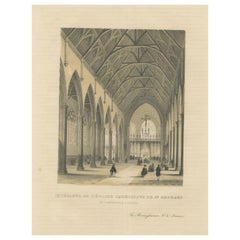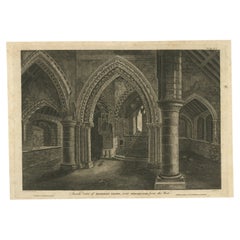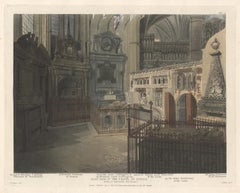Items Similar to St Sepulchre, The Round Church, Cambridge interior after Pugin for Ackermann
Want more images or videos?
Request additional images or videos from the seller
1 of 6
Rudolph AckermannSt Sepulchre, The Round Church, Cambridge interior after Pugin for Ackermann1814
1814
$305.37
£225
€262.68
CA$427.66
A$469.01
CHF 242.99
MX$5,635.53
NOK 3,058.87
SEK 2,870.84
DKK 1,962.48
About the Item
To see our other Oxford and Cambridge pictures, including an extensive collection of works by Ackermann, scroll down to "More from this Seller" and below it click on "See all from this Seller" - or send us a message if you cannot find the view you want.
John Hill (1770 - 1850) after Augustus Charles Pugin (1762 - 1832)
St Sepulchre's - The Round Church (1814)
Aquatint with original hand colouring
24 x 29 cm
Published by Rudolph Ackermann (1764 - 1834).
An interior engraving of the Church of the Holy Sepulchre, Cambridge, the round shape of which is inspired by the rotunda in the church of the Holy Sepulchre, Jerusalem.
John Hill was born in London in 1770, and was an engraver's apprentice. He worked in aquatint and largely produced book illustration aquatints. He went to America in 1816 and produced the notable Picturesque Views of American Scenery amongst other books of prints.
Augustus Charles Pugin was an Anglo-French artist and architectural draughtsman. Pugin produced views of London, jointly creating the illustrations for the 'Microcosm of London' published by Rudolph Ackermann in 1811, followed by plates for Ackermann's books about Westminster Abbey, Oxford and Cambridge universities, and Winchester College. His later works included illustrations for Specimens of Gothic Architecture (1821–1823), The Royal Pavilion at Brighton (1826), Architectural Antiquities of Great Britain (1826), Specimens of the Architectural Antiquities of Normandy (1827), Illustrations of the Public Buildings of London (1825 to 1828), Paris and its Environs (1829 to 1831), and Examples of Gothic Architecture (1831). He also produced a book of furniture designs called Gothic Furniture, and assisted architects with detailing for their gothic designs. He ran a drawing school at his house in Bloomsbury.
Ackermann was an Anglo-German bookseller, inventor, lithographer, publisher and businessman. He attended the Latin school in Stollberg, but his wish to study at the university was made impossible by lack of financial means, and he therefore became a saddler like his father.
He worked as a saddler and coach-builder in different German cities, moved from Dresden to Basel and Paris, and then, 23 years old, settled in London. He established himself in Long Acre, the centre of coach-making in London and close to the market at Covent Garden.
Ackermann then moved to Little Russell Street where he published Imitations of Drawings of Fashionable Carriages (1791) to promote his coach-making. Other publications followed. In 1795 he established a print-shop and drawing-school at 96 Strand. Here Ackermann set up a lithographic press and began a trade in prints. He later began to manufacture colours and thick carton paper for landscape and miniature painters. Within three years the premises had become too small and he moved to 101 Strand, in his own words "four doors nearer to Somerset House", the seat of the Royal Academy of Arts.
Between 1797 and 1800 Ackermann rapidly developed his print and book publishing business, encompassing many different genres including topography, caricature, portraits, transparencies and decorative prints.
During the Napoleonic wars, Ackermann was an energetic supporter of the Allied cause and made significant contributions to British propaganda through his publication of anti-Napoleonic prints and military manuals. He became a naturalised British citizen in March 1809.
As one of the pioneers of modern publishing methods, Ackermann developed an international distribution network for his publications and came to have significant commercial interests in South America. The business he founded in London flourished throughout the 19th century under the management of his descendants. He was buried at St. Clement Danes in the Strand, London.
In 2020, the St. Louis Mercantile Library wrote that:
"Ackermann excelled in the creation of landscape and architectural engravings. He created beautiful illustrations of the city of London, his adopted home, as well as two volumes of classic views of Westminster Abbey, along with exquisite views of river scenes. One of our favorite collections are four massive volumes of lovingly illustrated exterior and interior landmarks of Oxford and Cambridge Universities created just over two hundred years ago. These publications show Ackermann’s hand at every turn of the page along with the team of assistant designers and engravers he employed to create these works. Perhaps they were a way by which the artist could lay to rest his own regret at not being able to attend [an Oxbridge] college himself in a fondly depicted idyll to learning which these prints so aptly represent."
Rudolph Ackermann was an Anglo-German bookseller, inventor, lithographer, publisher and businessman. In 1795 he established a print-shop and drawing-school at 96 Strand. Here Ackermann set up a lithographic press and began a trade in prints. He later began to manufacture colours and thick carton paper for landscape and miniature painters. Within three years the premises had become too small and he moved to 101 Strand, in his own words "four doors nearer to Somerset House", the seat of the Royal Academy of Arts. Between 1797 and 1800 Ackermann rapidly developed his print and book publishing business, encompassing many different genres including topography, caricature, portraits, transparencies, and decorative prints.
About the Seller
4.8
Vetted Professional Seller
Every seller passes strict standards for authenticity and reliability
Established in 2014
1stDibs seller since 2017
359 sales on 1stDibs
Typical response time: 6 hours
- ShippingRetrieving quote...Shipping from: London, United Kingdom
- Return Policy
Authenticity Guarantee
In the unlikely event there’s an issue with an item’s authenticity, contact us within 1 year for a full refund. DetailsMoney-Back Guarantee
If your item is not as described, is damaged in transit, or does not arrive, contact us within 7 days for a full refund. Details24-Hour Cancellation
You have a 24-hour grace period in which to reconsider your purchase, with no questions asked.Vetted Professional Sellers
Our world-class sellers must adhere to strict standards for service and quality, maintaining the integrity of our listings.Price-Match Guarantee
If you find that a seller listed the same item for a lower price elsewhere, we’ll match it.Trusted Global Delivery
Our best-in-class carrier network provides specialized shipping options worldwide, including custom delivery.More From This Seller
View AllSt Sepulchre, The Round Church, Cambridge exterior after Pugin for Ackermann
Located in London, GB
To see our other Oxford and Cambridge pictures, including an extensive collection of works by Ackermann, scroll down to "More from this Seller" and below it click on "See all from this Seller" - or send us a message if you cannot find the view you want.
John Hill (1770 - 1850) after Augustus Charles Pugin (1762 - 1832)
St Sepulchre's - The Round Church (1814)
Aquatint with original hand colouring
24 x 29 cm
Published by Rudolph Ackermann (1764 - 1834).
An engraving of the Church of the Holy Sepulchre, Cambridge, the round shape of which is inspired by the rotunda in the church of the Holy Sepulchre, Jerusalem.
John Hill was born in London in 1770, and was an engraver's apprentice. He worked in aquatint and largely produced book illustration aquatints. He went to America in 1816 and produced the notable Picturesque Views of American Scenery amongst other books of prints.
Augustus Charles Pugin was an Anglo-French artist and architectural draughtsman. Pugin produced views of London, jointly creating the illustrations for the 'Microcosm of London' published by Rudolph Ackermann in 1811, followed by plates for Ackermann's books about Westminster Abbey, Oxford and Cambridge universities, and Winchester College. His later works included illustrations for Specimens of Gothic Architecture (1821–1823), The Royal Pavilion at Brighton (1826), Architectural Antiquities of Great Britain (1826), Specimens of the Architectural Antiquities of Normandy (1827), Illustrations of the Public Buildings of London (1825 to 1828), Paris and its Environs (1829 to 1831), and Examples of Gothic Architecture (1831). He also produced a book of furniture designs called Gothic Furniture, and assisted architects with detailing for their gothic designs. He ran a drawing school at his house in Bloomsbury.
Ackermann was an Anglo-German bookseller, inventor, lithographer, publisher and businessman. He attended the Latin school in Stollberg, but his wish to study at the university was made impossible by lack of financial means, and he therefore became a saddler like his father.
He worked as a saddler and coach-builder in different German cities, moved from Dresden to Basel and Paris, and then, 23 years old, settled in London. He established himself in Long Acre, the centre of coach-making in London and close to the market at Covent Garden.
Ackermann then moved to Little Russell Street where he published Imitations of Drawings of Fashionable Carriages (1791) to promote his coach-making. Other publications followed. In 1795 he established a print-shop and drawing-school at 96 Strand. Here Ackermann set up a lithographic press and began a trade in prints. He later began to manufacture colours and thick carton paper for landscape and miniature painters. Within three years the premises had become too small and he moved to 101 Strand, in his own words "four doors nearer to Somerset House", the seat of the Royal Academy of Arts.
Between 1797 and 1800 Ackermann rapidly developed his print and book publishing business, encompassing many different genres including topography, caricature, portraits, transparencies and decorative prints.
During the Napoleonic wars, Ackermann was an energetic supporter of the Allied cause and made significant contributions to British propaganda through his publication of anti-Napoleonic prints...
Category
1810s Prints and Multiples
Materials
Aquatint
Christ Church Cathedral, Oxford interior engraving by Bennett after Westall
Located in London, GB
To see our other Oxford and Cambridge pictures, including an extensive collection of works by Ackermann, scroll down to "More from this Seller" and below it click on "See all from th...
Category
1810s Realist Prints and Multiples
Materials
Engraving, Aquatint
Crypt of St Peter's Church, Oxford engraving by Bluck after Nash for Ackermann
Located in London, GB
To see our other Oxford and Cambridge pictures, including an extensive collection of works by Ackermann, scroll down to "More from this Seller" and below it click on "See all from th...
Category
1810s Prints and Multiples
Materials
Aquatint
Chapel of Lincoln College, Oxford by Lewis after Mackenzie for Ackermann
Located in London, GB
To see our other Oxford and Cambridge pictures, including an extensive collection of works by Ackermann, scroll down to "More from this Seller" and below it click on "See all from th...
Category
1810s Realist Prints and Multiples
Materials
Aquatint
Tom Tower, Christ Church, St Aldate's, Oxford by Hill after Pugin for Ackermann
Located in London, GB
To see our other Oxford and Cambridge pictures, including an extensive collection of works by Ackermann, scroll down to "More from this Seller" and below it click on "See all from this Seller" - or send us a message if you cannot find the view you want.
John Hill (1770 - 1850) after Augustus Charles Pugin (1762 - 1832)
St Aldate's From Carfax (1813)
Aquatint with original hand colouring
27 x 21 cm
Published by Rudolph Ackermann (1764 - 1834).
An engraving of St Aldate's, overlooked by Christ Church's pale and magnificent Tom Tower.
John Hill was born in London in 1770, and was an engraver's apprentice. He worked in aquatint and largely produced book illustration aquatints. He went to America in 1816 and produced the notable Picturesque Views of American Scenery amongst other books of prints.
Augustus Charles Pugin was an Anglo-French artist and architectural draughtsman. Pugin produced views of London, jointly creating the illustrations for the 'Microcosm of London' published by Rudolph Ackermann in 1811, followed by plates for Ackermann's books about Westminster Abbey, Oxford and Cambridge universities, and Winchester College. His later works included illustrations for Specimens of Gothic Architecture (1821–1823), The Royal Pavilion at Brighton (1826), Architectural Antiquities of Great Britain (1826), Specimens of the Architectural Antiquities of Normandy (1827), Illustrations of the Public Buildings of London (1825 to 1828), Paris and its Environs (1829 to 1831), and Examples of Gothic Architecture (1831). He also produced a book of furniture designs called Gothic Furniture, and assisted architects with detailing for their gothic designs. He ran a drawing school at his house in Bloomsbury.
Ackermann was an Anglo-German bookseller, inventor, lithographer, publisher and businessman. He attended the Latin school in Stollberg, but his wish to study at the university was made impossible by lack of financial means, and he therefore became a saddler like his father.
He worked as a saddler and coach-builder in different German cities, moved from Dresden to Basel and Paris, and then, 23 years old, settled in London. He established himself in Long Acre, the centre of coach-making in London and close to the market at Covent Garden.
Ackermann then moved to Little Russell Street where he published Imitations of Drawings of Fashionable Carriages (1791) to promote his coach-making. Other publications followed. In 1795 he established a print-shop and drawing-school at 96 Strand. Here Ackermann set up a lithographic press and began a trade in prints. He later began to manufacture colours and thick carton paper for landscape and miniature painters. Within three years the premises had become too small and he moved to 101 Strand, in his own words "four doors nearer to Somerset House", the seat of the Royal Academy of Arts.
Between 1797 and 1800 Ackermann rapidly developed his print and book publishing business, encompassing many different genres including topography, caricature, portraits, transparencies and decorative prints.
During the Napoleonic wars, Ackermann was an energetic supporter of the Allied cause and made significant contributions to British propaganda through his publication of anti-Napoleonic prints...
Category
1810s Prints and Multiples
Materials
Aquatint
St Mary's Church, Oxford engraving by Lewis after Nash for Ackermann
Located in London, GB
To see our other Oxford and Cambridge pictures, including an extensive collection of works by Ackermann, scroll down to "More from this Seller" and below it click on "See all from this Seller" - or send us a message if you cannot find the view you want.
Frederick Christian Lewis (1779 - 1856) after Frederick Nash (1782 - 1856)
St Mary's Church, Oxford (1813)
Aquatint with original hand colouring
21 x 27 cm
Published by Rudolph Ackermann (1764 - 1834).
Frederick Nash was born in Lambeth. He studied architectural drawing under Thomas Malton and then enrolled at the Royal Academy of Arts. From 1801 to 1809 he worked with the antiquarians John Britton and Edward Wedlake Brayley, subsequently becoming a member of the Society of Painters in Watercolours - a group of painters who had left the Royal Academy following complaints of under-recognition of their works. Nash became primarily a landscape painter and toured the rivers of Germany.
Frederick Christian Lewis was an English etcher, aquatint and stipple engraver, landscape and portrait painter. He studied under J. C. Stadler and in the schools of the Royal Academy and aquatinted most of Thomas Girtin's etchings of Paris...
Category
1810s Prints and Multiples
Materials
Aquatint
You May Also Like
St. Alban's Abbey Church, High Altar screen /// Robert Clutterbuck Hertford Art
Located in Saint Augustine, FL
Artist: Robert Clutterbuck (English, 1772-1831)
Title: "St. Alban's Abbey Church, High Altar screen"
Portfolio: The History and Antiquities of the County of Hertford
Year: 1815-1827 (First edition)
Medium: Original Engraving on wove paper
Limited edition: Unknown
Printer: Nichols, Son, and Bentley, London, UK
Publisher: Nichols, Son, and Bentley, London, UK
Reference: Brunet II, No. 112; Lowndes No. 483; BAL RIBA No. 666; Upcott I, page 623
Sheet size: 17.63" x 11.38"
Image size: 11.57" x 8.57"
Condition: Scattered foxing throughout sheet; it doesn't show much within the image. Creasing to upper left and right corners. Has been professionally stored away for decades. It is otherwise a strong impression in good condition
Notes:
Provenance: private collection - Aspen, CO. Engraved by English artist John Henry Le Keux (1812-1896) after a drawing by English artist Frederick Nash (1782-1856). Comes from Clutterbuck's three volume "The History and Antiquities of the County of Hertford", (1815-1827) (First edition), which consists of 54 engravings. Printed from one copper plate on one color: black. "Vol. I. p. 65" printed upper right in margin. "Proof" printed lower right in margin.
St Albans Cathedral, officially the Cathedral and Abbey Church of St Alban, also known as "the Abbey", is a Church of England cathedral...
Category
1810s Old Masters Interior Prints
Materials
Engraving, Intaglio
Lithograph of St. George's Church Interior Under Construction in London, 1843
Located in Langweer, NL
The lithograph is titled "Intérieur de l'Église Catholique de St. Georges en construction à Londres" and is signed by the artist "La Roquepin," which is likely a pseudonym or an abbr...
Category
Antique 1840s Prints
Materials
Paper
$170 Sale Price
20% Off
Inside View of Magdalen Chapel – Engraving of Medieval Gothic Interior, 1790
Located in Langweer, NL
Inside View of Magdalen Chapel – Engraving of Medieval Gothic Interior, 1790
This atmospheric antique engraving captures the interior of the Magdalen Chapel near Winchester, as view...
Category
Antique 18th Century English Prints
Materials
Paper
East Side of the Chapel of St Paul, Westminster Abbey, architecture aquatint
By John Bluck (active 1791-1819) after Frederick Mackenzie (1788-1854)
Located in Melbourne, Victoria
'East Side of the Chapel of St Paul'
Colour aquatint by John Bluck (active 1791-1819) after Frederick Mackenzie (1788-1854).
Architectural interior with superb original colour. Fro...
Category
Early 19th Century Naturalistic Landscape Prints
Materials
Engraving, Etching, Aquatint
West View of St Nicholas Chapel, Westminster Abbey, architecture aquatint
Located in Melbourne, Victoria
Colour aquatint by John Bluck (active 1791-1819) after Auguste Pugin (1762-1832).
Architectural interior with superb original colour. From 'Westminster Abbey', published by Rudolf A...
Category
Early 19th Century Naturalistic Landscape Prints
Materials
Engraving, Etching, Aquatint
West Side of the Chapel of St Paul, Westminster Abbey, architecture aquatint
By John Bluck (active 1791-1819) after Frederick Mackenzie (1788-1854)
Located in Melbourne, Victoria
Colour aquatint by John Bluck (active 1791-1819) after Frederick Mackenzie (1788-1854).
Architectural interior with superb original colour. From 'Westminster Abbey', published by Ru...
Category
Early 19th Century Naturalistic Landscape Prints
Materials
Engraving, Etching, Aquatint
More Ways To Browse
Antique Mercantile
Royal Pavilion
Holy Sepulchre
Henri Matisse Original Lithographs
Henry Moore Etching
Japanese Print Gold
Jazz Festival Poster
Katz Morris
Keith Haring 1984
Leroy Neiman Signed
Marc Chagall Jerusalem Windows
Marchal Poster
Mark Kostabi On Sale
Michelangelo Original
Nara Lithograph
New Coke
Notre Dame Etching
Original Intaglio
